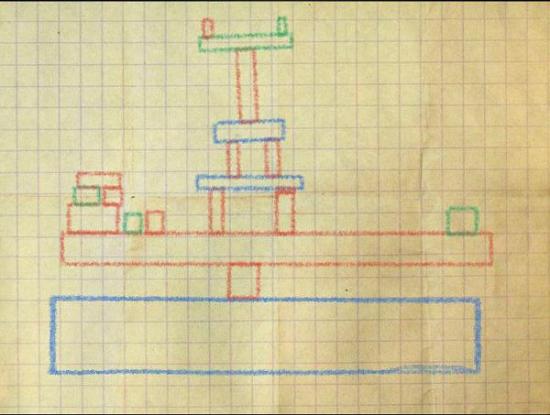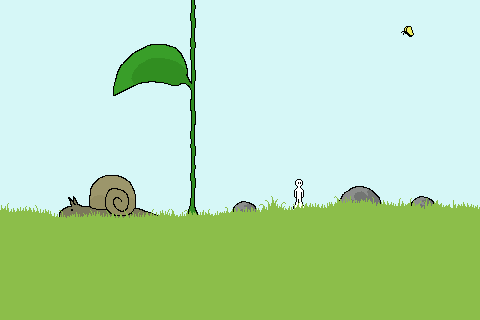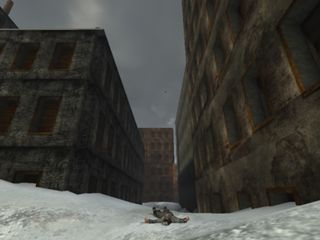On Chalk, Crayon and Seiklus
Thursday, June 28, 2007 4:42:51 PM
The PC is the great equalizer, not just in terms of news, media and the internet, but also in terms of games and what can be achieved. Developer's for major companies can come up with great ideas, there is no doubting that, but they are limited by a thing called the bottom line, if an idea will only appeal to a very small group of people (when the company wants to reach a large group of people) then the idea probably won't make it into the game. Because of that they cannot explore every possible gameplay design they have thought of, nor can they create and implement every graphical element or style they dream up. This is where the PC (though the consoles may soon be able to do this on a larger scale due to downloadable content) becomes a great avenue for those untapped ideas. While there are many games out there that are innovative, filled with fresh ideas that hopefully will reach a wide audience, the focus for now will be on three (well four, three in a title looks cleaner) for the moment: Chalk, Crayon, Blocksum and Seiklus.
 [/IMG]
[/IMG]
Chalk in Action
Chalk is a brilliant game with a simple premise that gives way to a very enjoyable time. Put simply, you control a character who floats through scrolling levels, you can draw using chalk anywhere on the screen (though you have a limit of time to how much chalk is in each line). Using this premise the game throws enemies and environmental object your way, you must use the chalk to make different combos (such as drawing a chalk line from an enemy's bullet to the enemy in order to hurt the enemy) while at the same time using the chalk to protect your character from harm (such as drawing a shield made of chalk to protect your character from oncoming bullets). These simple elements give way to much fun as the game adds twist to the basic premise (especially during boss fights) to keep you thinking about how to best use the chalk. When first playing this game, many would think of how good it would be on the Nintendo DS, direct control of the chalk due to the touchscreen would greatly enhance the players accuracy, plus it could be assume the developer could come up with a creative way to use the second screen. Maybe someday we will see a game like this on the Nintendo DS, as the system still has much to offer. This game is almost a childhood dream come to life, a chalkboard coming to life as you battle different enemies and solving puzzles; easily a game worth playing.
 [/IMG]
[/IMG]
An example of Crayon outside normal gameplay, took couple of minutes
Crayon has certain gameplay elements similar to Chalk, and is just as fun (probably more so depending on how you choose to play). In this game you aim to solve puzzles by getting a rolling ball to a star using your ability to draw objects on the screen (for the most part rectangular objects). At its most basic it is a puzzle game in which you are given certain parameters in which to get an object from point A to point B, but there is much more to the game than that, if only you have the mindset to explore and go beyond just solving puzzles. The game utilizes some degree of physics on every object you create, so if you draw a rectangle half off of a cliff, it will most likely tip and fall off. This physics engine comes into play is during regular gameplay, but once you beat the game (which would take a relatively short time) you can play around with this engine, trying to see how you either can solve the same puzzle but in a more elaborate (or simple) way. Also, though, you can play with the engine, try to create a balance and see how much weight you can continually put on each side to keep it balanced or even construct a simply building and see how much stuff you can put on it while keeping it upright (the example above implements both these idea in one structure). This is nothing extremely new, but the context, drawing with crayons, is simple and fun and can be enjoyed by most anyone.
 [/IMG]
[/IMG]
Over to soon?
The two previous titles have one issue that traditional developers might see, they are too short. This is less of a problem as it is a stigma, the video game industry has cultivated this thought that if a game is not a certain length (such as the 10 hour campaign length for a First Person Shooter) then the length of the game should be extended by either adding more levels or increasing the difficulty. This seems wrong on a fundamental level, are books lengthened on purpose because they are not perceived to be long enough? No usually. This may actually be hindering the industry as good ideas that are better played for a short period of time are destroyed or changed in order for the play time to be increased, but more on that in a later post, now on to the great puzzler Blocksum.
 [/IMG]
[/IMG]
Blocksum
Blocksum is a puzzler, somewhat in the same vein as tetris in that you want to stop the blocks from filling up the screen, but from there the comparison ends (mostly). The premise of the game is to clear the blocks (each block has a number such as 1, 2 or 5) that appear by adding blocks that touch each other together. The best way to explain the next part is an example, suppose there were four number 1 blocks, you connect one pair on number 1 blocks and then connect the other pair of number 1 blocks, this creates two number 2 blocks which are then cleared. If the same thing happened, but the blocks added up to three, you would need at least three number 3 blocks to clear the number 3 blocks. Once you are playing the game it is all very simple, but this game brings up a great issue, how to make educational games fun. It seems sometimes that many educational games figure out the education part first then tact on the game, usually bringing about subpar results. While the author of this game probably was not intending to make it for educational purposes, if applied right this game could be a great way to kids to learn their basic numbers and adding them in different ways (and looking a step further, if instead of adding each touching block it multiplied them, you could do even more). This game is fun and addictive and it could be seen (once played) how this could be very educational, hopefully in the future more developers will think of an interesting gameplay idea then add on the educational parts as they go (or like Blocksum (and to some extent games like Age of Empires) make them educational without knowing).
 [/IMG]
[/IMG]
Seiklus
Seiklus is a game like Knytt, or more accurately Knytt is a game like Seiklus. In the post previous to this the game Knytt is reviewed and many of the points such as the great atmosphere created in the game, are represented greatly here. This game is talked about here less for the innovation it brings and more for what the industry needs, a short (couple hours at most) game that is highly enjoyable and probably would not have been made better by adding onto its length. This game is everything a platformer should be: the level design is great; the character has weight and is easy to control; and the atmosphere is great, from the music to the look of each level. It would be a joy to see, instead of the next 2 million pixel per gun FPS, a game like this on the Xbox360, PS3 or Wii (or PC), use the increase power of those systems to create a gorgeous 2-D platformer that does not aim to be the next Halo, Gran Turismo or Metal Gear Solid. With the introduction of the different Marketplaces on each console, the game would not have to be a full retail release, just pay $5 and get a short but sweet experience that a longer game cannot replicate. When playing this game you start to wonder why every game that comes out, even 'simple' platformers, tend to have health bars, lives and some sort of gimmick to keep things complicated (and supposedly interesting). This game you have no real health bar, lives or gimmicky system, like Knytt this game is pure platforming, running and jumping and exploring a world ready to be taken in. While complicated systems and game mechanics are fine and enjoyable, sometimes it is fun once in awhile to be able to just react and take in the game world without having to worry about whether you have enough gold to buy the new sword in the next city.
Downloads for the Games:
Seiklus
Crayon
Chalk
Blocksum
 [/IMG]
[/IMG]Chalk in Action
Chalk is a brilliant game with a simple premise that gives way to a very enjoyable time. Put simply, you control a character who floats through scrolling levels, you can draw using chalk anywhere on the screen (though you have a limit of time to how much chalk is in each line). Using this premise the game throws enemies and environmental object your way, you must use the chalk to make different combos (such as drawing a chalk line from an enemy's bullet to the enemy in order to hurt the enemy) while at the same time using the chalk to protect your character from harm (such as drawing a shield made of chalk to protect your character from oncoming bullets). These simple elements give way to much fun as the game adds twist to the basic premise (especially during boss fights) to keep you thinking about how to best use the chalk. When first playing this game, many would think of how good it would be on the Nintendo DS, direct control of the chalk due to the touchscreen would greatly enhance the players accuracy, plus it could be assume the developer could come up with a creative way to use the second screen. Maybe someday we will see a game like this on the Nintendo DS, as the system still has much to offer. This game is almost a childhood dream come to life, a chalkboard coming to life as you battle different enemies and solving puzzles; easily a game worth playing.
An example of Crayon outside normal gameplay, took couple of minutes
Crayon has certain gameplay elements similar to Chalk, and is just as fun (probably more so depending on how you choose to play). In this game you aim to solve puzzles by getting a rolling ball to a star using your ability to draw objects on the screen (for the most part rectangular objects). At its most basic it is a puzzle game in which you are given certain parameters in which to get an object from point A to point B, but there is much more to the game than that, if only you have the mindset to explore and go beyond just solving puzzles. The game utilizes some degree of physics on every object you create, so if you draw a rectangle half off of a cliff, it will most likely tip and fall off. This physics engine comes into play is during regular gameplay, but once you beat the game (which would take a relatively short time) you can play around with this engine, trying to see how you either can solve the same puzzle but in a more elaborate (or simple) way. Also, though, you can play with the engine, try to create a balance and see how much weight you can continually put on each side to keep it balanced or even construct a simply building and see how much stuff you can put on it while keeping it upright (the example above implements both these idea in one structure). This is nothing extremely new, but the context, drawing with crayons, is simple and fun and can be enjoyed by most anyone.
Over to soon?
The two previous titles have one issue that traditional developers might see, they are too short. This is less of a problem as it is a stigma, the video game industry has cultivated this thought that if a game is not a certain length (such as the 10 hour campaign length for a First Person Shooter) then the length of the game should be extended by either adding more levels or increasing the difficulty. This seems wrong on a fundamental level, are books lengthened on purpose because they are not perceived to be long enough? No usually. This may actually be hindering the industry as good ideas that are better played for a short period of time are destroyed or changed in order for the play time to be increased, but more on that in a later post, now on to the great puzzler Blocksum.
 [/IMG]
[/IMG]Blocksum
Blocksum is a puzzler, somewhat in the same vein as tetris in that you want to stop the blocks from filling up the screen, but from there the comparison ends (mostly). The premise of the game is to clear the blocks (each block has a number such as 1, 2 or 5) that appear by adding blocks that touch each other together. The best way to explain the next part is an example, suppose there were four number 1 blocks, you connect one pair on number 1 blocks and then connect the other pair of number 1 blocks, this creates two number 2 blocks which are then cleared. If the same thing happened, but the blocks added up to three, you would need at least three number 3 blocks to clear the number 3 blocks. Once you are playing the game it is all very simple, but this game brings up a great issue, how to make educational games fun. It seems sometimes that many educational games figure out the education part first then tact on the game, usually bringing about subpar results. While the author of this game probably was not intending to make it for educational purposes, if applied right this game could be a great way to kids to learn their basic numbers and adding them in different ways (and looking a step further, if instead of adding each touching block it multiplied them, you could do even more). This game is fun and addictive and it could be seen (once played) how this could be very educational, hopefully in the future more developers will think of an interesting gameplay idea then add on the educational parts as they go (or like Blocksum (and to some extent games like Age of Empires) make them educational without knowing).
 [/IMG]
[/IMG]Seiklus
Seiklus is a game like Knytt, or more accurately Knytt is a game like Seiklus. In the post previous to this the game Knytt is reviewed and many of the points such as the great atmosphere created in the game, are represented greatly here. This game is talked about here less for the innovation it brings and more for what the industry needs, a short (couple hours at most) game that is highly enjoyable and probably would not have been made better by adding onto its length. This game is everything a platformer should be: the level design is great; the character has weight and is easy to control; and the atmosphere is great, from the music to the look of each level. It would be a joy to see, instead of the next 2 million pixel per gun FPS, a game like this on the Xbox360, PS3 or Wii (or PC), use the increase power of those systems to create a gorgeous 2-D platformer that does not aim to be the next Halo, Gran Turismo or Metal Gear Solid. With the introduction of the different Marketplaces on each console, the game would not have to be a full retail release, just pay $5 and get a short but sweet experience that a longer game cannot replicate. When playing this game you start to wonder why every game that comes out, even 'simple' platformers, tend to have health bars, lives and some sort of gimmick to keep things complicated (and supposedly interesting). This game you have no real health bar, lives or gimmicky system, like Knytt this game is pure platforming, running and jumping and exploring a world ready to be taken in. While complicated systems and game mechanics are fine and enjoyable, sometimes it is fun once in awhile to be able to just react and take in the game world without having to worry about whether you have enough gold to buy the new sword in the next city.
Downloads for the Games:
Seiklus
Crayon
Chalk
Blocksum








Dan Alexandrudantesoft # Thursday, June 28, 2007 4:59:40 PM
http://newsvote.bbc.co.uk/mpapps/pagetools/print/news.bbc.co.uk/2/hi/technology/6248780.stm
Dan Alexandrudantesoft # Sunday, November 18, 2007 1:16:25 PM
gaara42GaaraZanta # Sunday, November 18, 2007 6:13:21 PM